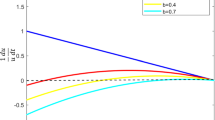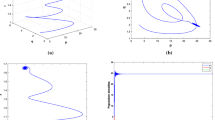Abstract
Spatial memory and predator-induced fear have recently been considered in modeling population dynamics of animals independently. This paper is the first to integrate both aspects in a prey-predator model with pregnancy cycle to investigate the direct and indirect effects of predation on the spatial distribution of prey. We extensively study Turing instability and Hopf bifurcation. When the prey population has slow memory-based diffusion, the model is easier to generate Turing patterns. While when the prey population has fast memory-based diffusion, the model can exhibit rich dynamics. Specifically, (1) for the model with spatial memory delay only, the prey population with long term memory shows a spatially nonhomogeneous periodic distribution; (2) for the model with pregnancy delay only, the prey population with long pregnancy cycles shows a spatially homogeneous (or nonhomogeneous) periodic distribution, and (3) for the model with both the two time delays, more interesting spatiotemporal dynamics can be observed for long memory delay and (or) long pregnancy cycles. Our findings indicate that both spatial memory and pregnancy cycle play significant roles in the pattern formation of prey-predator interactions.












Similar content being viewed by others
References
An Q, Beretta E, Kuang Y, Wang C, Wang H (2019) Geometric stability switch criteria in delay differential equations with two delays and delay dependent parameters. J Diff Equ 266(11):7073–7100
An Q, Wang C, Wang H (2020) Analysis of a spatial memory model with nonlocal maturation delay and hostile boundary condition. Disc Continuous Dyn Syst 40(10):5845–5868
Clinchy M, Sheriff MJ, Zanette LY, Boonstra R (2013) Predator-induced stress and the ecology of fear. Funct Ecol 27(1):56–65
Cooke KL, Den Driessche PV (1996) Analysis of an seirs epidemic model with two delays. J Math Biol 35(2):240–260
Du Y, Niu B, Wei J (2019) Two delays induce hopf bifurcation and double hopf bifurcation in a diffusive leslie-gower predator-prey system. Chaos 29(1):013101
Fagan WF, Lewis MA, Augermethe M, Avgar T, Benhamou S, Breed GA, Ladage LD, Schlagel UE, Tang W, Papastamatiou YP et al (2013) Spatial memory and animal movement. Ecol Lett 16(10):1316–1329
Gu K, Niculescu S, Chen J (2005) On stability crossing curves for general systems with two delays. J Math Anal Appl 311(1):231–253
Jackson M, Chencharpentier BM (2017) Modeling plant virus propagation with delays. J Comput Appl Math 309:611–621
Jia D, Zhang T, Yuan S (2019) Pattern dynamics of a diffusive toxin producing phytoplankton-zooplankton model with three-dimensional patch. Int J Bifurc Chaos 29(4):1930011
Kumar A, Dubey B (2019) Modeling the effect of fear in a prey-predator system with prey refuge and gestation delay. Int J Bifurc Chaos 29(14):1950195
Lin X, Wang H (2012) Stability analysis of delay differential equations with two discrete delays. Canadian Appl Math Quart 20(4):519–533
Martin A, Ruan S (2001) Predator-prey models with delay and prey harvesting. J Math Biol 43(3):247–267
May RM (1973) Time-delay versus stability in population models with two and three trophic levels. Ecology 54(2):315–325
Mondal S, Maiti A, Samanta GP (2018) Effects of fear and additional food in a delayed predator-prey model. Biophys Rev Lett 13(04):157–177
Montagnes DJS, Zhu X, Gu L, Sun Y, Wang J, Horner R, Yang Z (2019) False exclusion: a case to embed predator performance in classical population models. Am Nat 194(5):654–670
Potts JR, Lewis MA (2019) Spatial memory and taxis-driven pattern formation in model ecosystems. Bull Math Biol 81(7):2725–2747
Preisser EL, Bolnick DI, Benard MF (2005) Scared to death? the effects of intimidation and consumption in predator-prey interactions. Ecology 86(2):501–509
Qu Y, Wei J, Ruan S (2010) Stability and bifurcation analysis in hematopoietic stem cell dynamics with multiple delays. Physica D Nonlinear Phenomena 239(20):2011–2024
Ruan S, Wei J (2003) On the zeros of transcendental functions with applications to stability of delay differential equations with two delays. Dyn Continuous Disc Impuls Syst 10(6):863–874
Shi J, Wang C, Wang H (2019) Diffusive spatial movement with memory and maturation delays. Nonlinearity 32(9):3188–3208
Shi J, Wang C, Wang H, Yan X (2020) Diffusive spatial movement with memory. J Dyn Diff Equ 32(2):979–1002
Shi Q, Shi J, Song Y (2017) Hopf bifurcation in a reaction-diffusion equation with distributed delay and dirichlet boundary condition. J Diff 263(10):6537–6575
Shi Q, Shi J, Song Y (2019) Hopf bifurcation and pattern formation in a delayed diffusive logistic model with spatial heterogeneity. Disc Continuous Dyn Syst-Series B 24(2):467–486
Sommers P, Chesson P (2019) Effects of predator avoidance behavior on the coexistence of competing prey. Am Nat 193(5):E132–E148
Song Y, Peng Y, Wei J (2008) Bifurcations for a predator-prey system with two delays. J Math Anal Appl 337(1):466–479
Song Y, Wu S, Wang H (2019) Spatiotemporal dynamics in the single population model with memory-based diffusion and nonlocal effect. J Diff Equ 267(11):6316–6351
Song Y, Peng Y, Zhang T (2021) The spatially inhomogeneous hopf bifurcation induced by memory delay in a memory-based diffusion system. J Diff Equ 300:597–624
Sun G (2016) Mathematical modeling of population dynamics with allee effect. Nonlinear Dyn 85(1):1–12
Travers M, Clinchy M, Zanette L, Boonstra R, Williams TD (2010) Indirect predator effects on clutch size and the cost of egg production. Ecol Lett 13(8):980–988
Wang H, Nagy JD, Gilg O, Kuang Y (2009) The roles of predator maturation delay and functional response in determining the periodicity of predator-prey cycles. Math Biosci 221(1):1–10
Wang X, Zou X (2017) Modeling the fear effect in predator-prey interactions with adaptive avoidance of predators. Bull Math Biol 79(6):1325–1359
Wang X, Zou X (2018) Pattern formation of a predator-prey model with the cost of anti-predator behaviors. Math Biosci Eng 15(3):775–805
Wang X, Zanette L, Zou X (2016) Modelling the fear effect in predator-prey interactions. J Math Biol 73(5):1179–1204
Wang Y, Zou X (2020) On a predator-prey system with digestion delay and anti-predation strategy. J Nonlinear Sci 30(4):1579–1605
Wang YX, Li WT (2019) Spatial patterns of a predator-prey model with beddington-deangelis functional response. Int J Bifurc Chaos 29(11):1950145
Yan S, Jia D, Zhang T, Yuan S (2020) Pattern dynamic in a diffusive predator-prey model with hunting cooperations. Chaos Solitons Fractals 130:109428
Yang J, Yuan S (2021) Dynamics of a toxic producing phytoplankton-zooplankton model with three-dimensional patch. Appl Math Lett 118:107146
Zanette L, White AF, Allen MC, Clinchy M (2011) Perceived predation risk reduces the number of offspring songbirds produce per year. Science 334(6061):1398–1401
Zhang S, Yuan S, Zhang T (2022) A predator-prey model with different response functions to juvenile and adult prey in deterministic and stochastic environments. Appl Math Comput 413:126598
Acknowledgements
The authors would like to thank the two anonymous referees for their valuable comments and suggestions which have greatly improved this paper.
Author information
Authors and Affiliations
Corresponding author
Ethics declarations
Conflict of interest
The authors declare that they have no conflict of interest.
Additional information
Publisher's Note
Springer Nature remains neutral with regard to jurisdictional claims in published maps and institutional affiliations.
Cuihua Wang and Sanling Yuan are supported by National Natural Science Foundation of China (11671260; 12071293); Hao Wang is supported by Natural Sciences and Engineering Research Council of Canada (Discovery Grant RGPIN-2020-03911 and Accelerator Supplement Grant RGPAS-2020-00090).
Rights and permissions
About this article
Cite this article
Wang, C., Yuan, S. & Wang, H. Spatiotemporal patterns of a diffusive prey-predator model with spatial memory and pregnancy period in an intimidatory environment. J. Math. Biol. 84, 12 (2022). https://doi.org/10.1007/s00285-022-01716-4
Received:
Revised:
Accepted:
Published:
DOI: https://doi.org/10.1007/s00285-022-01716-4
Keywords
- Spatial memory
- Predator-induced fear
- Pregnancy period
- Delay reaction-diffusion equations
- Pattern formation
- Stability and Hopf bifurcation




